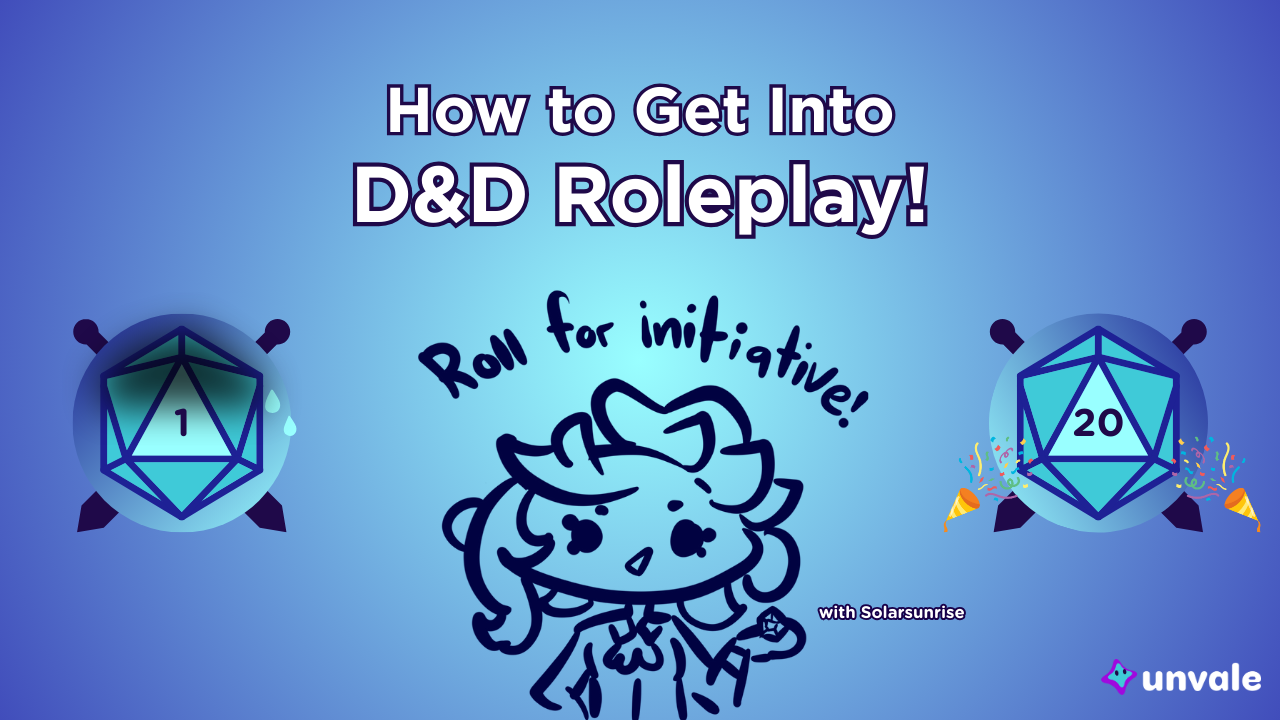How to Get Into D&D Roleplay! A Simple Guide

For those just stumbling upon this article, D&D, also known as Dungeons and Dragons, is a well-established table top role-playing game (TTRPG) widely popular across the world. Other games include Vampire: The Masquerade, Pathfinder, and Call of Cthulhu, but D&D greatly eclipses all others in terms of simplicity and accessibility.
This article is mainly intended for D&D players (or those who have cool D&D OCs on Unvale), but as someone who has played TTRPGs for nearly a decade, this guide should be equally applicable to all other TTRPGs. Additionally, TTRPGs can be played in person and online, and because of that, table etiquette and role-playing style can vary greatly.
Table of contents:
- Setting Expectations
- Voice Acting
- Physicality
- Integrate your Backstory into the World
- Work with the Numbers
Setting Expectations
Before ink is even printed on your character sheet or stats are rolled, you must set expectations with the group. Sit down as a group and discuss.
- What kind of story do you want to create?
- Are you comfortable with character death?
- How familiar and comfortable is everyone with roleplay?
- How comfortable is everyone with in-game romance?
As an example, my Game Master (aka GM, a generalized form of Dungeon Master or Story Teller) asked me before the session if I was comfortable with a Non-Player Character (NPC) flirting with my Player Character (PC). I was fine with it, and I was subsequently handed a rose made out of meat by a stand-up comedian next session.
Even though it was simple and cute (and no, you won't get to know the context), my GM checking in with me made the situation much more comfortable. For more flirty PCs and NPCs, checking in with other players (and your GM!) about their comfort levels with romance and adult content is a must.
Additionally, if you or one of your fellow players is coming in fresh from watching D&D Podcasts like Critical Role or Nat 19, it’s important to mention that you and your group are (probably) not skilled voice actors with highly developed improv skills. Improvisation and acting don't come naturally to everyone, and some of your new party members might be a bit stiff; so the rest of the article will focus on how to get into roleplay proper.
Voice Acting
Okay I literally just said that you and your group probably aren't professional VAs, but still!
There’s a bit of a difference between speaking with a different pitch and a full on “character voice”. Firstly, if you want to speak like a horrid little kobold all session, you need to be able to keep it up for three (or more!) hours without damaging your voice. This involves testing out what voices you can manage comfortably.
The problem with voices is that we’re all physically unique, which affects our vocal cords. Training your voice to a pitch it’s not naturally at is both difficult and takes time (but it’s absolutely possible!) and some voices are just not capable of straining themselves beyond certain pitches, and that’s okay! Your vocal range doesn't limit the kinds of characters you can play.
If you have a naturally deep voice and want to play a gorgeous and elegant maiden, all you need to do is simply soften your voice. Imagine how you might speak quietly to a small child to soothe them. Add an accent, if you want! Your voice will naturally take on a sense of warmth if you channel that sort of energy. The key is to be able to make it fully clear when you, the player, is talking, versus Miranda the elven Life Domain Cleric.
A lot of character comes from tone, but what about emotions? As a former theatre kid, the concept I heard a lot was to imagine a time in your life when you felt that emotion and act it out, rather than putting yourself in a fictional situation. Even if you’re not playing in person or with video, you should also still make the expression of the emotion you’re trying to convey. You can hear a person smiling when they speak if you listen carefully, and that’s due to the physical changes in their body required to smile.
So, quick recap on voice acting!
- Be able to be consistent, but don't hurt your voice! Find voices that you can do comfortably.
- Your vocal range doesn't limit what characters you can play.
- Try softening your voice, deepening your voice, or even add an accent!
- Make it clear when you the player is talking versus your character talking.
- Don't forget to add emotions both in facial expression and tone. It helps!
Physicality
You can skip this section if you only play online without cameras, but this is about how to physically get into character. How you hold yourself can help you show the other players what kind of character you’re playing; whether you sit up straight and look down your nose, or hunch over and avoid eye contact, your physical appearance will help others imagine your character.
You can also:
- Make or find props to help show your character’s habits, like rubbing a locket when talking about their family.
- Cosplay causally or professionally as your character, whether it be elf ears from a costume shop or a simple straw hat or scarf.
- Style your hair differently, like putting it up in a ponytail or using bobby pins to style your bangs in a part or side swept.
- Use a plush toy to represent your familiar (ambush your GM with an attack by your 3 foot tall Cyndaquil plush!)
Integrate your Backstory into the World
D&D is not a game where you can hide crucial backstory information from your GM, nor is a game where you can give your GM nothing and expect them to create a fantastic and deep backstory for you.
Even if you have a backstory figured out, you need to sometimes accept that other players might have a more integrated backstory than you. If you’re from another city or country, you might have less attachment to the local goings on; and that’s okay! It’s good to be patient and wait for your GM to add things for you, or if you feel left out, you should always talk to them about it.
As an example, my character Lilia was raised by Pokémon for the first portion of her life and was adopted by humans later, so she doesn't have a family background like the other characters in our game. But this gives context to other parts of her character; she is able to emotionally connect to Pokémon through a mysterious power of hers, and that’s something that other characters can't do. So, my GMs do a lot with this power and connect it to the story for me.
Like I mentioned in the roleplay opener article months ago, a good hook in RP is everything. Having a lot for your GM to work with is highly beneficial. So spill everything about your character to them!
To summarize!
- Backstories play a big role in roleplaying.
- Sometimes others will have more in-depth backstories and that's ok! Yours is still plenty important.
- If you feel left out, talk to your GM about it to help.
- Different types of backstories can allow for cool new types of perspectives and context!
Work with the Numbers
What the heck does that mean? Well, in TTRPGs, each action is ruled by the dice and your stats. A good roleplayer works with the numbers rather than fights them.
For instance, say you have a character who has a low intelligence stat, but a high wisdom stat. You’re bummed out because you don't want to play a dumb character who can't contribute. But actually, you have a chance to play a super interesting character! They might struggle to learn, but they’re quick witted and sharp about the world around them, emotionally intelligent and good with practical knowledge. Or maybe you’re playing a character with a low constitution and high charisma; your character is a bit sickly and weak, but very pretty, well-spoken, or just funny and great to be around. Each stat is a chance to develop your character in a certain way. Not every party member will be the smart one, the strong one, or the tough one, but that's the point of a party; to cover each other’s weaknesses.
Now, as for the dice; if you’ve played any TTRPG before, you’ve felt the highs and lows of critical failures and critical successes. Once, I rolled three nat 20s in a row and sprinted through the fabric of reality. Another time, I verbally fumbled and outed a couple for being together- actually, I didn't roll for that one.
Anyways, the point is that you can and should use your dice rolls in your roleplay. Roleplay your failures and successes in equal measure, and you’ll end up having a blast! Fighting to keep your character looking cool and perfect won't work; in any D&D game, you will miss, get poisoned or injured, fall into a pit trap or accidentally hit your ally. It’s going to happen, so play into it! Maybe an enemy that rolled a critical hit on you left a nasty scar.
What we learned here
- Actions are ruled by your dice rolls and your stats.
- Your stats allows your to lean into really different types of characters. Use them to your advantage!
- Everyone has a role in your party, but working together you all cover each other's weaknesses!
- Dice rolls will affect how successful you are and how badly you fail. Roleplay both types of results equally in character and you'll have a great time!
Phew! That turned out to be a lot, huh? Nice work reading through it all. While Dungeons and Dragons is a numbers based game, it also thrives on the storytelling from both the GM and the players. Learning how to roleplay more effectively might help your group members feel more confident and comfortable role-playing themselves, so always try to gently initiate those who seem a bit more nervous or shy. If you support others, you’ll find yourself with a fantastic party in no time!
And don't forget to check out the cool DnD and TTRPG OCs over on Unvale! They might leave you with some cool inspirations for your next character.

